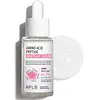What's inside
What's inside
 Key Ingredients
Key Ingredients

 Benefits
Benefits

 Ingredients Side-by-side
Ingredients Side-by-side

Water
Skin ConditioningMethylpropanediol
SolventButylene Glycol
HumectantGlycerin
HumectantPentylene Glycol
Skin ConditioningPEG-60 Hydrogenated Castor Oil
Emulsifying1,2-Hexanediol
Skin ConditioningSodium Hyaluronate
HumectantPropanediol
SolventEthylhexylglycerin
Skin ConditioningCopper Tripeptide-1
Skin ConditioningAdenosine
Skin ConditioningBeta-Glucan
Skin ConditioningDisodium EDTA
Centella Asiatica Extract
CleansingHouttuynia Cordata Extract
Skin ConditioningSalvia Hispanica Seed Extract
EmollientCaprylyl Glycol
EmollientAcetyl Hexapeptide-8
HumectantPhenoxyethanol
PreservativeWater, Methylpropanediol, Butylene Glycol, Glycerin, Pentylene Glycol, PEG-60 Hydrogenated Castor Oil, 1,2-Hexanediol, Sodium Hyaluronate, Propanediol, Ethylhexylglycerin, Copper Tripeptide-1, Adenosine, Beta-Glucan, Disodium EDTA, Centella Asiatica Extract, Houttuynia Cordata Extract, Salvia Hispanica Seed Extract, Caprylyl Glycol, Acetyl Hexapeptide-8, Phenoxyethanol
Water
Skin ConditioningCentella Asiatica Leaf Water
Skin ConditioningButylene Glycol
HumectantPropanediol
SolventGlycerin
HumectantDiethoxyethyl Succinate
SolventArginine
MaskingSh-Oligopeptide-1
Skin ConditioningMadecassic Acid
Skin ConditioningAsiaticoside
AntioxidantAsiatic Acid
Skin ConditioningSqualane
EmollientSolanum Melongena Fruit Extract
Skin ConditioningMelaleuca Alternifolia Leaf Extract
PerfumingBeta-Glucan
Skin ConditioningHippophae Rhamnoides Fruit Extract
Skin ConditioningNelumbo Nucifera Extract
Skin ConditioningArtemisia Annua Extract
MaskingOryza Sativa Extract
AbsorbentSaccharomyces Ferment
Skin ConditioningDipropylene Glycol
HumectantSodium Citrate
BufferingSodium Hyaluronate
HumectantAllantoin
Skin ConditioningCellulose Gum
Emulsion StabilisingDisodium EDTA
Glyceryl Acrylate/Acrylic Acid Copolymer
HumectantCitric Acid
BufferingXanthan Gum
EmulsifyingInulin
Skin ConditioningCellulose
AbsorbentGlucose
HumectantFructose
HumectantPanthenol
Skin ConditioningEthylhexylglycerin
Skin ConditioningHydroxyacetophenone
AntioxidantSodium Polyacryloyldimethyl Taurate
Emulsion StabilisingDipotassium Glycyrrhizate
Humectant1,2-Hexanediol
Skin ConditioningWater, Centella Asiatica Leaf Water, Butylene Glycol, Propanediol, Glycerin, Diethoxyethyl Succinate, Arginine, Sh-Oligopeptide-1, Madecassic Acid, Asiaticoside, Asiatic Acid, Squalane, Solanum Melongena Fruit Extract, Melaleuca Alternifolia Leaf Extract, Beta-Glucan, Hippophae Rhamnoides Fruit Extract, Nelumbo Nucifera Extract, Artemisia Annua Extract, Oryza Sativa Extract, Saccharomyces Ferment, Dipropylene Glycol, Sodium Citrate, Sodium Hyaluronate, Allantoin, Cellulose Gum, Disodium EDTA, Glyceryl Acrylate/Acrylic Acid Copolymer, Citric Acid, Xanthan Gum, Inulin, Cellulose, Glucose, Fructose, Panthenol, Ethylhexylglycerin, Hydroxyacetophenone, Sodium Polyacryloyldimethyl Taurate, Dipotassium Glycyrrhizate, 1,2-Hexanediol
 Reviews
Reviews

Ingredients Explained
These ingredients are found in both products.
Ingredients higher up in an ingredient list are typically present in a larger amount.
1,2-Hexanediol is a synthetic liquid and another multi-functional powerhouse.
It is a:
- Humectant, drawing moisture into the skin
- Emollient, helping to soften skin
- Solvent, dispersing and stabilizing formulas
- Preservative booster, enhancing the antimicrobial activity of other preservatives
Beta-Glucan is a polysaccharide. It can be derived from the cell walls of seaweed, oats, yeast, and fungi. It hydrates the skin and helps boost your skin's natural barrier.
As an antioxidant, beta-glucan helps fight free-radicals. Free-radicals are molecules that may damage your skin cells, such as pollution.
Studies show this ingredient may be an effective wrinkle reducer as it can deeply penetrate into skin. It has also been show to help with wound healing.
Learn more about Beta-GlucanButylene Glycol (or BG) is used within cosmetic products for a few different reasons:
Overall, Butylene Glycol is a safe and well-rounded ingredient that works well with other ingredients.
Though this ingredient works well with most skin types, some people with sensitive skin may experience a reaction such as allergic rashes, closed comedones, or itchiness.
Learn more about Butylene GlycolDisodium EDTA plays a role in making products more stable by aiding other preservatives.
It is a chelating agent, meaning it neutralizes metal ions that may be found in a product.
Disodium EDTA is a salt of edetic acid and is found to be safe in cosmetic ingredients.
Learn more about Disodium EDTAEthylhexylglycerin (we can't pronounce this either) is commonly used as a preservative and skin softener. It is derived from glyceryl.
You might see Ethylhexylglycerin often paired with other preservatives such as phenoxyethanol. Ethylhexylglycerin has been found to increase the effectiveness of these other preservatives.
Glycerin is already naturally found in your skin. It helps moisturize and protect your skin.
A study from 2016 found glycerin to be more effective as a humectant than AHAs and hyaluronic acid.
As a humectant, it helps the skin stay hydrated by pulling moisture to your skin. The low molecular weight of glycerin allows it to pull moisture into the deeper layers of your skin.
Hydrated skin improves your skin barrier; Your skin barrier helps protect against irritants and bacteria.
Glycerin has also been found to have antimicrobial and antiviral properties. Due to these properties, glycerin is often used in wound and burn treatments.
In cosmetics, glycerin is usually derived from plants such as soybean or palm. However, it can also be sourced from animals, such as tallow or animal fat.
This ingredient is organic, colorless, odorless, and non-toxic.
Glycerin is the name for this ingredient in American English. British English uses Glycerol/Glycerine.
Learn more about GlycerinPropanediol is an all-star ingredient. It softens, hydrates, and smooths the skin.
It’s often used to:
Propanediol is not likely to cause sensitivity and considered safe to use. It is derived from corn or petroleum with a clear color and no scent.
Learn more about PropanediolSodium Hyaluronate is hyaluronic acid's salt form. It is commonly derived from the sodium salt of hyaluronic acid.
Like hyaluronic acid, it is great at holding water and acts as a humectant. This makes it a great skin hydrating ingredient.
Sodium Hyaluronate is naturally occurring in our bodies and is mostly found in eye fluid and joints.
These are some other common types of Hyaluronic Acid:
Learn more about Sodium HyaluronateWater. It's the most common cosmetic ingredient of all. You'll usually see it at the top of ingredient lists, meaning that it makes up the largest part of the product.
So why is it so popular? Water most often acts as a solvent - this means that it helps dissolve other ingredients into the formulation.
You'll also recognize water as that liquid we all need to stay alive. If you see this, drink a glass of water. Stay hydrated!
Learn more about Water